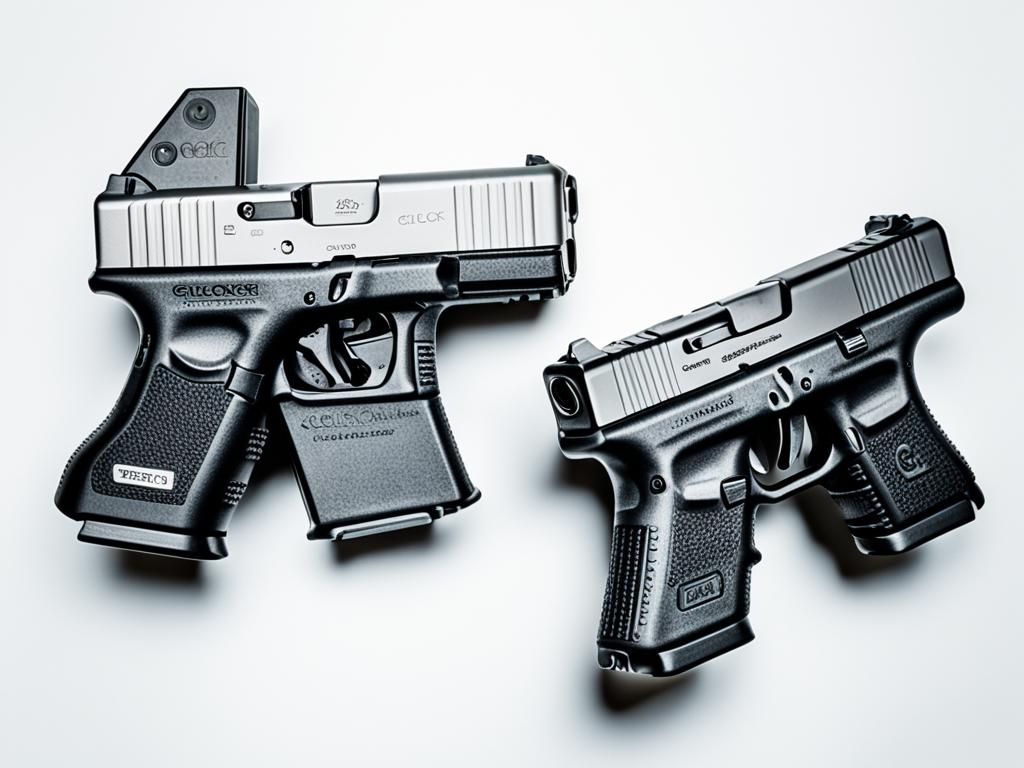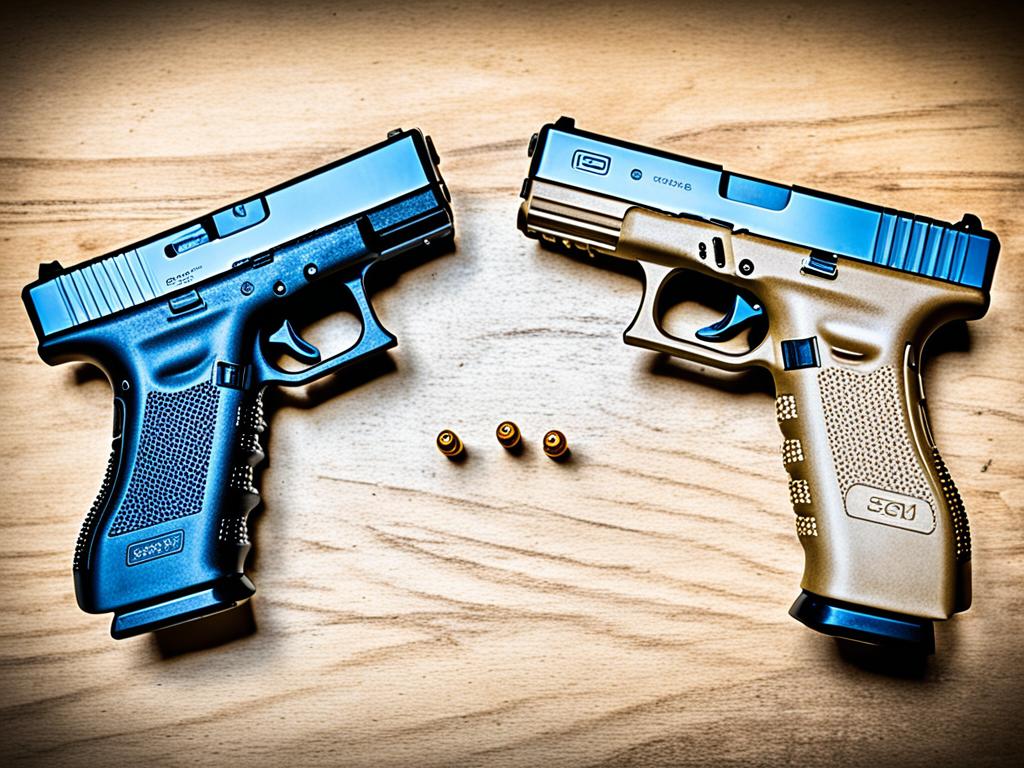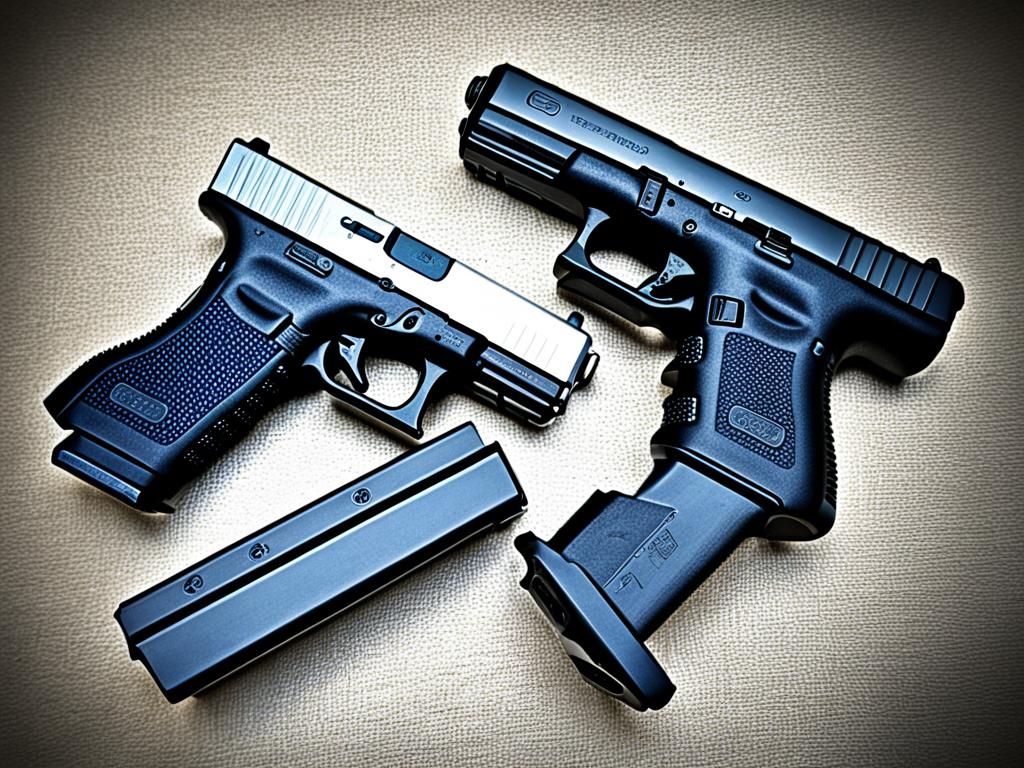Did you know that Glock pistols are the most popular handguns in the United States, with over 65% of law enforcement agencies opting for their reliable performance and trusted reputation? If you’re considering purchasing a Glock handgun, it’s essential to understand the differences between models to make an informed decision. In this comparison guide, we will take a close look at the Glock 20 and Glock 21, two powerhouse pistols that have garnered widespread acclaim among firearms enthusiasts.
Key Takeaways:
- Discover the distinctions between the Glock 20 and Glock 21
- Understand the impact of ammunition variation on ballistics
- Compare the design and dimensions of these firearms
- Evaluate the performance aspects like accuracy and recoil
- Determine which Glock model is best suited for your shooting needs
Glock 20 vs Glock 21 – Ammo
The main difference between the Glock 20 and Glock 21 lies in the ammunition they use. The Glock 20 is chambered in 10mm Auto, while the Glock 21 is chambered in .45 ACP. These two cartridges have distinct characteristics and performance attributes, which we will discuss in detail.
The Glock 20 was specifically designed to chamber the powerful 10mm Auto cartridge. This cartridge offers a high velocity and energy, making it a popular choice for both self-defense and hunting purposes. With a larger bullet diameter, the 10mm Auto delivers excellent stopping power, making it capable of neutralizing threats effectively.
On the other hand, the Glock 21 is chambered in .45 ACP (Automatic Colt Pistol), a renowned cartridge known for its reliability and proven stopping power. The .45 ACP is a slower and heavier round compared to the 10mm Auto, but it delivers a larger bullet diameter, resulting in a larger wound channel upon impact. This makes it a favored choice among law enforcement agencies and individuals looking for a reliable self-defense handgun.
Comparing the Glock 20 vs Glock 21 Ammo:
- The 10mm Auto offers higher muzzle velocity and energy compared to the .45 ACP.
- The .45 ACP provides a larger bullet diameter, resulting in a larger wound channel.
- The 10mm Auto has a flatter trajectory and less bullet drop at longer distances.
- The .45 ACP has a reputation for its proven stopping power.
- The availability of ammunition may vary depending on your location and preferences.
Whether you prioritize velocity, energy, wound channel size, or stopping power, the choice between the Glock 20 and Glock 21 ultimately comes down to your specific needs and preferences. Understanding the differences in their ammunition is crucial in selecting the firearm that aligns with your shooting requirements.
Glock 20 vs Glock 21 – Ballistics
When it comes to comparing the ballistics of the Glock 20 and Glock 21, several factors need to be considered, including muzzle velocity, bullet weight, and energy. These factors play a crucial role in determining the terminal performance and overall shooting experience of each firearm.
The Glock 20, chambered in 10mm Auto, packs a punch with its higher muzzle velocity and bullet weight. The 10mm cartridge delivers exceptional energy, making it a popular choice among hunters and outdoor enthusiasts. The increased velocities provide flatter trajectories and improved long-range performance.
In contrast, the Glock 21 is chambered in .45 ACP, a robust round known for its stopping power. While the .45 ACP may have a lower muzzle velocity compared to the 10mm Auto, it compensates with its larger bullet diameter and weight. This results in a significant impact on terminal ballistics, making it an excellent choice for self-defense and close-range encounters.
Both cartridges have their advantages and excel in different scenarios. The choice between the Glock 20 and Glock 21 will ultimately depend on your specific needs and preferences. If you prioritize long-range accuracy, the Glock 20’s 10mm Auto cartridge may be the better option for you. On the other hand, if close-quarters self-defense is your priority, the Glock 21’s .45 ACP provides formidable stopping power.
It’s important to note that recoil can also differ between these two models due to the variations in cartridge performance. The higher muzzle energy of the 10mm Auto in the Glock 20 may result in slightly more felt recoil compared to the .45 ACP of the Glock 21. However, individual shooter preferences and techniques can influence the perceived recoil, so it’s advisable to test fire both models to determine which one feels more comfortable for you.
| Glock 20 | Glock 21 | |
|---|---|---|
| Muzzle Velocity | Varies depending on bullet weight and load | Varies depending on bullet weight and load |
| Bullet Weight | 10mm Auto | .45 ACP |
| Energy | High | Considerable |
| Terminal Ballistics | Flatter trajectories, improved long-range performance | Formidable stopping power, larger bullet diameter |
| Recoil | May have slightly more felt recoil due to higher muzzle energy | Slightly less felt recoil compared to the Glock 20 |
Glock 20 vs Glock 21 – Design and Dimensions
When it comes to the design and dimensions, the Glock 20 and Glock 21 share many similarities. However, there are minor differences in their weight and dimensions that can impact the overall shooting experience. Let’s take a closer look at the physical aspects of these firearms to help you better understand their differences.
Glock 20 Dimensions:
- Length: 8.22 inches
- Height: 5.47 inches
- Width: 1.27 inches
- Weight (unloaded): 30.71 ounces
Glock 21 Dimensions:
- Length: 8.03 inches
- Height: 5.47 inches
- Width: 1.27 inches
- Weight (unloaded): 29.84 ounces
As you can see, the Glock 20 is slightly longer than the Glock 21. However, both models share the same height and width, providing a similar grip and handling experience. In terms of weight, the Glock 20 is slightly heavier by approximately 0.87 ounces.

These slight differences in weight and dimensions may influence your decision depending on your shooting preferences. If you prioritize a lighter firearm, the Glock 21 could be a better option. However, if you prefer a slightly longer barrel or prefer the added weight for recoil control, the Glock 20 might be the ideal choice.
Now that we’ve explored the design and dimensions, let’s move on to the next section, where we will analyze the performance of the Glock 20 and Glock 21 in various shooting scenarios.
Glock 20 vs Glock 21 – Performance
When it comes to performance, the Glock 20 and Glock 21 both deliver outstanding results in real-world shooting situations. Let’s dive into the various performance metrics to understand how these handguns handle.
Accuracy
The accuracy of a handgun is essential for precise shooting. Both the Glock 20 and Glock 21 are known for their impressive accuracy, allowing shooters to consistently hit their targets. Whether you prefer the 10mm Auto chambering of the Glock 20 or the .45 ACP chambering of the Glock 21, you can expect reliable accuracy from either model.
Recoil
Recoil can greatly influence the shooting experience and follow-up shot accuracy. The Glock 20 chambered in 10mm Auto generally generates more recoil than the Glock 21 chambered in .45 ACP. However, with proper technique and grip, both models can be manageable, providing a comfortable shooting experience even for those sensitive to recoil.
Trigger
The trigger is a crucial component in a handgun, affecting both accuracy and overall shooting experience. The Glock 20 and Glock 21 feature similar trigger configurations, offering a consistent pull with short reset times to ensure quick follow-up shots.

Other Performance Metrics
In addition to accuracy, recoil, and trigger, there are other performance metrics to consider when choosing between the Glock 20 and Glock 21. These may include ergonomics, sight options, magazine capacity, and aftermarket support. It’s important to evaluate these factors based on your specific shooting needs and preferences.
Overall, both the Glock 20 and Glock 21 exhibit exceptional performance characteristics, offering shooters reliable accuracy, manageable recoil, and a consistent trigger. The choice between these two models ultimately depends on individual preference, shooting requirements, and the chambering that best suits your needs.
Which Glock is Right for Me? – Conclusion
After comparing the Glock 20 and Glock 21 in terms of ammo, ballistics, design, dimensions, and performance, it’s time to determine which Glock model is right for you.
If you’re looking for a powerful handgun with a flatter shooting trajectory and higher magazine capacity, the Glock 20 chambered in 10mm Auto is an excellent choice. Its ability to deliver higher muzzle velocity and energy makes it ideal for hunting and self-defense situations where penetration and stopping power are crucial.
On the other hand, if you prefer the classic and proven .45 ACP round and prioritize a more manageable recoil, the Glock 21 is the way to go. It offers a slightly larger bullet diameter and is favored by many law enforcement personnel and tactical shooters due to its stopping power and ease of use.
In the end, your decision should be driven by your shooting needs, preferences, and the specific scenarios in which you plan to use the handgun. Consider factors such as ammunition availability, shooting experience, and intended use carefully before making your final choice. The information provided in this guide should help you make an informed decision and find the Glock model that suits you perfectly.
FAQ
What is the main difference between the Glock 20 and Glock 21?
The main difference lies in the ammunition they use. The Glock 20 is chambered in 10mm Auto, while the Glock 21 is chambered in .45 ACP.
How do the ballistics of the Glock 20 and Glock 21 compare?
The different cartridges they use result in variations in muzzle velocity, bullet weight, and energy, leading to differences in terminal performance and recoil.
How do the design and dimensions of the Glock 20 and Glock 21 differ?
While the design and dimensions are similar, there are minor differences in weight and physical dimensions that set them apart.
How do the Glock 20 and Glock 21 perform in terms of accuracy and recoil?
Both models are highly regarded handguns, but we will analyze their accuracy, recoil, trigger, and other performance metrics to provide a comprehensive understanding of their performance.
How can I determine which Glock model is right for me?
By considering the differences and factors discussed in this guide, you can make an informed decision based on your specific shooting needs and preferences.

Leave a Reply